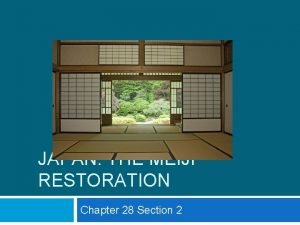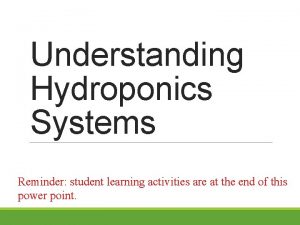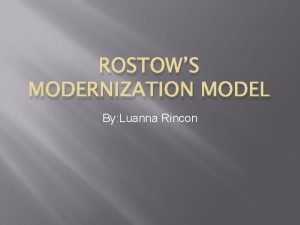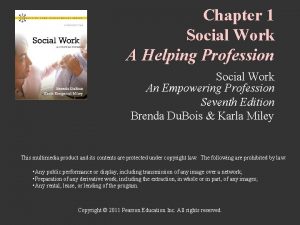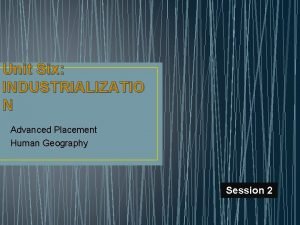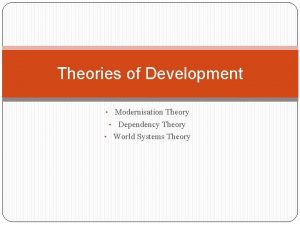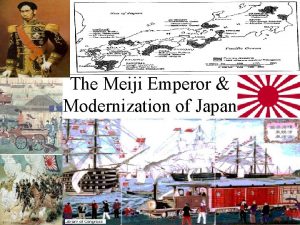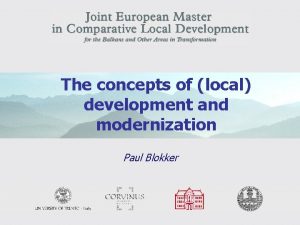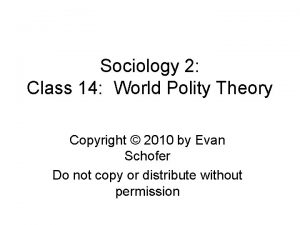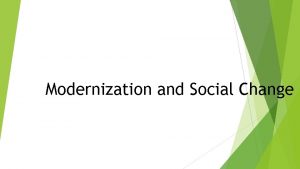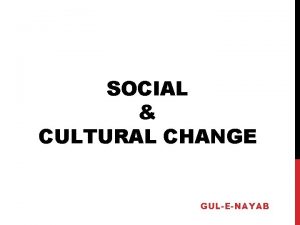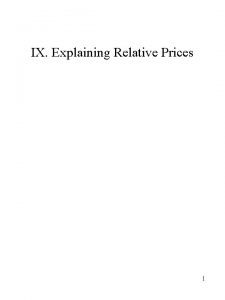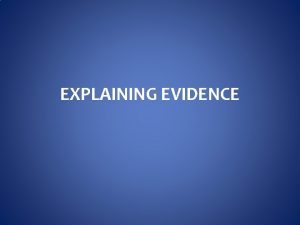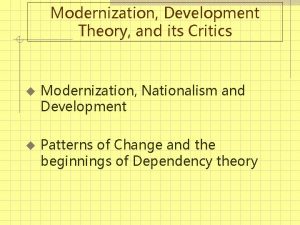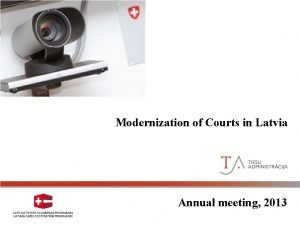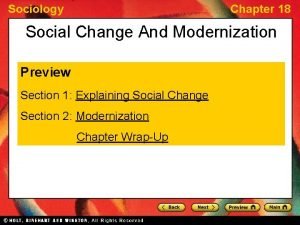Chapter 18 Social Change and Modernization Explaining Social




























- Slides: 28

Chapter 18 Social Change and Modernization

Explaining Social Change • Social change is the alterations in various aspects of society over time. • There are four broad categories used to explain social change: • Cyclical Theory • Evolutionary Theory • Equilibrium Theory • Conflict Theory

Explaining Social Change Cyclical Theory of Social Change • This views change from a historical perspective. • Societies arise, go through various stages of development, and then decline. • This theory views change as part of a continuing process. • Oswald Spengler and Pitirim Sorokin are the two main cyclical theorists

Explaining Social Change • Oswald Spengler was a German Historian concerned with WWI. • He wrote The Decline of the West a book about how all societies pass through four stages • • Childhood Youth Adulthood Old age • He believed that western civilization is bound to decline and disappear in it’s “old age” like all other great civilizations have.

Explaining Social Change • Pitirim Sorokin is a Russian American sociologist. • He believed all societies fluctuated between two extreme forms of culture • Ideational culture in which truth and knowledge are sought via faith or religion • Sensate culture in which knowledge is sought via science • Sometimes societies would find a middle ground between the two extremes • Idealistic culture • Principle of immanent change is the natural tendency for social change

Explaining Social Change Evolutionary Theory of Social Change • Views change as a process that moves in one direction • towards increasing complexity. • As members of society attempt to adapt to social and physical conditions of the environment, they push the society forward in development. • Early evolutionary theorists and modern social evolutionists differ in their views on how society changes.

Explaining Social Change Early Evolutionary Theories • All societies progress through the same stages. • Viewed western civilization as the height of development. • Comte – three stages of development • Explain events via the supernatural • Explain events via religion or philosophy • Explain events via science • Spenser – social Darwinsim “survival of the fittest” • Very popular in the late 1800’s and early 1900’s

Explaining Social Change Modern Evolutionary Theories • Believes societies have a tendency to become more complex over time. • Does not assume change always produces progress or that it is the same in all societies. • Attempts to explain why societies change, unlike early evolutionary theorists. • Gerhard Lenski and Jean Lenski argue that change in society is due to it’s economy and level of technology.

Explaining Social Change Equilibrium Theory of Social Change • Works on the functionalist perspective. • Society resembles a living organism that must attempt to stability and that is why social change occurs. • When stability is disrupted by change in one part of the system, the other parts adapt to bring back balance/equilibrium. • When order is restored, the new system is slightly different than the old system thus social change takes place.

Explaining Social Change Equilibrium Theory of Social Change • Talcott Parson’s states that social equilibrium is maintained through evolutionary change. • Evolutionary change occurs in a two-step process of differentiation and integration. • As society becomes more complex, its social institutions become more numerous and more distinct. • The new institutions must work with the others to ensure social stability is maintained.

Explaining Social Change Conflict Theory of Social Change • Change results from conflicts between groups with opposing interests. • They view conflict as a natural condition in all societies and change as inevitable.

Explaining Social Change Karl Marx and Class Conflict • Marx believed that all of human history is the history of class conflict. • All societies have been subject to conflicts between the “haves” and “have nots”. • Social change is a result of efforts by the “have nots” to gain power over the “haves”.

Explaining Social Change Ralf Dahrendorph and Social Conflict • He agreed with Marx that conflict is a central feature of all societies BUT disagreed with Marx’s idea that class conflict is the moving force in human history. • He also does not believe that revolutions is the principle way to resolve conflict in modern industrial society like Marx • He believed conflict can take many forms • Racial/ethnic groups • Men and women • Young and old

Modernization • Modernization is the process by which a society’s social institutions become increasingly complex as the society moves towards industrialization. • This is the focus of sociologists studying social change. • Areas of interest: • Social change in less developed countries • Effects of modernization on social life and the environment

Modernization Theory • States that the more developed nations modernized because they were the first to industrialize. • Once less developed nations start to industrialize, they too will become modernized. • Over time less developed nations will resemble more developed nations in terms of: • Economic and social structure • Norms • Values

Modernization Theory • This view also states that extended family structure will be replaced by the nuclear family as less developed nations modernize. • The role of religion guiding interaction will also decrease as a country modernizes. • Mass education will arise with modernization. • The majority of the population will move from rural to urban areas with modernization.

Modernization Theory • Modernization theorists assume that less developed nations will be able to raise the standard of living and become part of the world economy as they industrialize. • Money, technology, and economic advisors flooded less developed nations to try and speed up the process of industrialization, but had little impact. • As a result, support for the modernization theory has weakened

Modernization • Less developed nations have a history of economic dependence on the West due to colonization. • Population pressures faced in less developed nations are vastly different from those in more developed nations. • Less developed nations industrialize with an already large population instead of growing as they industrialize. • Many lesser developed nations show antimodernization sentiments. • Taliban

Modernization World Systems Theory • This theory looks at modernization in terms of the world economy. • Immanuel Wallerstein suggested that there are three types of nations: • Core • Peripheral • Semiperipheral

Modernization World Systems Theory • Core nations are the most powerful developed nations that for the center or core of the world economy. • They control most of the world’s productive, technological, and financial resources. • Core nations include: • USA • Canada • Japan

Modernization World Systems Theory • Peripheral Nations are the poor countries in Latin America, Asia, and Africa. • They control few productive resources and they depended on core nations for financial aid, technology, and manufactured goods. • They also depend on core nations to buy their raw materials and rely on the exportation of these raw materials. • Coffee • Cocoa • Sugar

Modernization World Systems Theory • Semiperipheral nations are between core and peripheral nations. • They may be industrialized, but not a major player in the world economy. • Semiperipheral nations include: • Smaller Western European nations (Spain & Portugual) • Newly developed nations in Asia (South Korea and Taiwan)

Modernization World Systems Theory • On the surface the economic relationships between the various types of nations appear to be a positive relationship, but the arrangement creates a lack of : • economic diversity • Dependence on core nations • Increased economic inequality • This slows the economic growth of less developed nations.

Modernization Consequences of Modernization • Modernization has both positive and negative effects on social life and the natural environment. • The positive consequences are an increased standard of living. • Longer life expectancy • Lower birth rates • Higher rates of literacy • Decrease in economic and social inequality • More personal comforts

Modernization Consequences of Modernization • Modernization offers benefits such as: • The growth of industry • Expansion of technological development • Improved infrastructure: • Better roads • Better ports • Other facilities

Modernization Consequences of Modernization • Modernization is often accompanied by the arrival of electricity and communication technology. • However these can be limited to the wealthy and not everyone in developing nations. • Modernization also establishes educations institutions such as colleges and universities.

Modernization Consequences of Modernization • Modernization also has some costs. The same improvements of standard of living and prolonged life also cause problems. • Family and religion lose authority • Government takes on a larger role in people’s personal lives • Feelings of isolation • Conflicting norms and role expectations.

Modernization Consequences of Modernization • Modernization also gives rise to moral and ethical questions. • How long should a doctor try and prolong the life of someone who is terminally ill with modern medical technology • The effects of modernization also effect the natural environment. • Problems with soil, water, and air pollution • Use of pesticides create environmental and health problems • Creation of hazardous waste
 Chapter 28 section 2 modernization in japan
Chapter 28 section 2 modernization in japan Differentiate globalization from modernization
Differentiate globalization from modernization Explaining hydroponics systems
Explaining hydroponics systems Explaining voltage
Explaining voltage What is the purpose of an explanation
What is the purpose of an explanation How to describe trends in graphs
How to describe trends in graphs A pamphlet explaining how an unborn child
A pamphlet explaining how an unborn child Explaining deviance biological perspect
Explaining deviance biological perspect Templates for explaining quotations
Templates for explaining quotations Quotation starters
Quotation starters Behavioural approach to treating phobias
Behavioural approach to treating phobias Explaining patterns hots
Explaining patterns hots Function of uterine cavity
Function of uterine cavity Aqa alevel psychology
Aqa alevel psychology Conclusion of education and modernization
Conclusion of education and modernization Social change in social work
Social change in social work Example of chemical change
Example of chemical change Absolute change and relative change formula
Absolute change and relative change formula Difference between a chemical and physical change
Difference between a chemical and physical change Supply and demand curve shifts
Supply and demand curve shifts Which is an example of a physical change
Which is an example of a physical change Rocks change due to temperature and pressure change
Rocks change due to temperature and pressure change Whats physical change
Whats physical change First-order change and second-order change examples
First-order change and second-order change examples Modernization model ap human geography
Modernization model ap human geography Modernization theory vs dependency theory
Modernization theory vs dependency theory Modernization in japan
Modernization in japan Conclusion of modernization
Conclusion of modernization World polity theory definition
World polity theory definition
